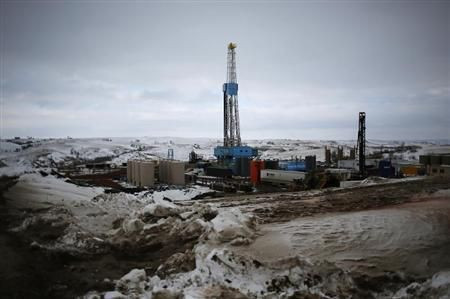IEA Says ‘Supply Shock’ From North American Shale And Tar Sands Is Transforming Global Energy Scene

It’s news that Saudi oil sheikhs must be cringing to read: The International Energy Agency says the boom in North American crude oil production because of hydraulic fracturing and Canada’s tar sands is transforming the global oil market.
Not only will the new sources help the region dominate growth in the global oil supply over the next five years, but also the technology that has allowed access to previously unattainable sources of light crude will be adopted in other parts of the world, causing a significant reassessment of countries’ proven oil reserves.
“North America has set off a supply shock that is sending ripples throughout the world,” said IEA Executive Director Maria van der Hoeven, who released the report at the Platts Crude Oil Summit in London. “The technology that unlocked the bonanza in places like North Dakota can and will be applied elsewhere, potentially leading to a broad reassessment of reserves.”
North America is expected to produce 3.9 million more barrels of oil per day by 2018, representing more than half of the growth outside of the 12 members of the Organization of the Petroleum Exporting Countries. Meanwhile, OPEC countries, which include Saudi Arabia, Nigeria, Venezuela and Iran, will see demand this year for their oil fall below a self-imposed limit of 30 million barrels per day.
The IEA recently downgraded its forecast for OPEC capacity growth, from 37.5 million barrels per day by 2017 to 36.7 million barrels per day by 2018.
That’s not the only transformation going on in the global oil market. The IEA also pointed out that in this quarter, for the first time, countries that aren't members of the Organization for Economic Cooperation and Development will overtake OECD countries in oil demand. In other words: the developing world, including the African continent, most of South America and almost all of Asia, is thirstier for fossil fuel than North America, most of Europe and Russia.
Corresponding increases in refinery capacity in these developing countries coupled with supply growth from North America will cause the production of oil to grow “significantly faster” than demand, to help provide a “more comfortable global supply/demand balance over the next five years,” according to the Paris-based organization that represents the interests of wealthy economies.
The IEA predicts that the U.S. could become the world’s largest oil producer by 2020, if only temporarily. Saudi Arabia was the world’s largest oil producer last year, followed by Russia and the U.S.
"There is hardly any aspect of the global oil supply chain that will not undergo some measure of transformation over the next five years, with significant consequences for the global economy and oil security," the IEA said.
Read an overview of the report here.
Check out the IEA’s slideshow presentation here.
© Copyright IBTimes 2024. All rights reserved.












